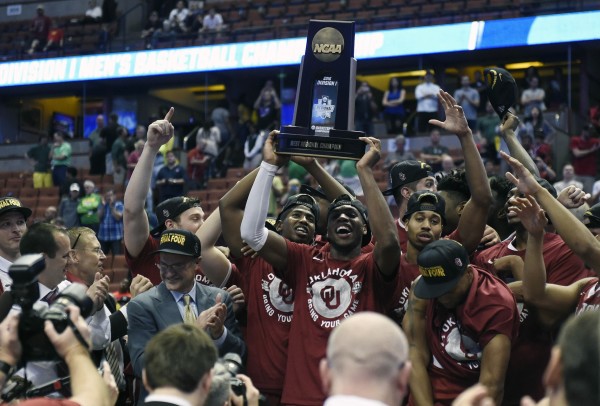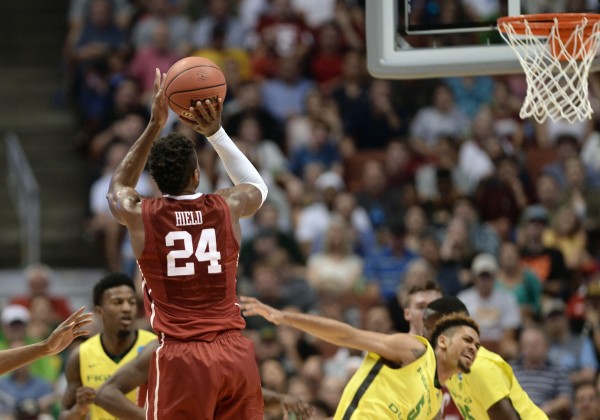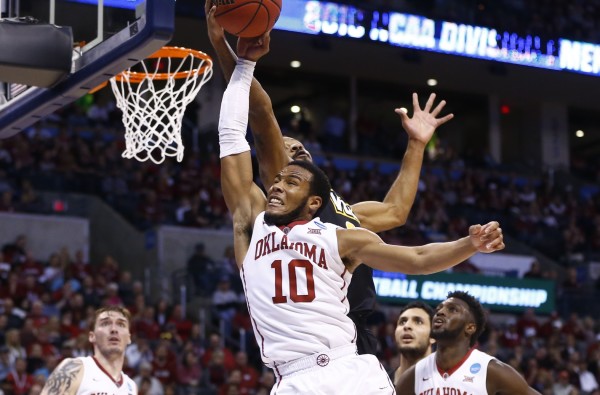Final Four Fact Sheet: Oklahoma Sooners
Posted by Andrew Murawa (@Amurawa) on March 29th, 2016Now that the Final Four is set, our writers have put together a fact sheet on each of the four teams still remaining. Next, Oklahoma.
How Oklahoma Got Here
West Region Champions. After sleepwalking for the better part of the afternoon in their opener against Cal State Bakersfield, the Sooners found themselves down a single point with 15 minutes remaining. From there, a familiar story played out – one that would be repeated often on Oklahoma’s run to Houston: Buddy Hield took over. In the remainder of the game, Hield threw in 16 of his game-high 27 points to drag his team to the second round. From there it was a repeat performance, as Hield went off for a 29-point second half against VCU, including 22 points in the final 11 minutes after the Rams had come back from 13 down to tie the game. A Sweet Sixteen victory over Texas A&M allowed Hield to “only” go for 17 points (along with 10 boards in his sole double-double of the season) in a game that was never particularly close. But Buddy bounced back in a big way, scorching Oregon for 37 phenomenal points (including eight threes) to earn the Sooners’ first trip to the Final Four since 2002.
The Coach
Lon Kruger. This is Kruger’s 30th season of coaching a Division I basketball program. He started at Texas-Pan American in 1982, taking the independent program to a 20-win season in his fourth year. After getting hired by Kansas State in 1986, he brought on a little-known coach named Dana Altman from Moberly Area Community College — someone who happened to have a kid named Mitch Richmond on his team. The future Hall of Famer followed Altman to Manhattan and the Wildcats subsequently went to an Elite Eight in Richmond’s senior season. A coaching star was officially born. Kansas State went to the NCAAs in all four seasons Kruger spent in Manhattan, and he turned that run into a coaching upgrade at Florida in 1990. In his fourth season with the Gators, Kruger took Andrew DeClercq, Dan Cross and Craig Brown to the 1994 Final Four, the only other time he made it to his sport’s final weekend. Since then, Kruger spent time at Illinois, the Atlanta Hawks and UNLV, before settling in Norman five seasons ago. He’s taken five Division I teams to the NCAA Tournament, four to the Sweet Sixteen, three to the Elite Eight, and now two to the Final Four.
Style
At 16.1 seconds per possession, Oklahoma is among the most uptempo offensive teams in the country. But the Sooners’ ability to extend defensive pressure and apply half-court traps can slow down opponents’ offenses, something to keep an eye on against their decidedly down-tempo Final Four opponent. More than anything else, however, Kruger’s team is defined by its ability to shoot the three-pointer. A full 40 percent of this team’s field goal attempts come from behind the arc, and they make a robust 42.8 percent of those, good for second-best in the nation. Still, don’t mistake the Sooners for only a three-point shooting team. All three of their starting guards – Buddy Hield, Jordan Woodard and Isaiah Cousins – have an ability to create off the bounce and get to the rim or drop a dime to an open shooter or a crashing big man. This combination of attacking styles makes Oklahoma the 13th-most efficient offensive basketball team in the country. But as Oregon found out in the Elite Eight, this isn’t just a flashy team; there’s plenty of grit here as well. The Sooners’ ability to challenge jumpers, defend without fouling and take opposing teams out of their comfort zones makes them equally efficient on the defensive end, where they also rank 13th in the nation.
Strengths
- Three-Point Shooting. You probably know about Buddy Hield. He takes better than 50 percent of his field goal attempts from deep and drains 46.4 percent of those attempts. But he’s just one of several deadly marksmen on this team. Junior point guard Jordan Woodard takes 48.8 percent of his attempts from behind the three-part line and makes 46 percent as well. Senior Isaiah Cousins isn’t quite as three-heavy ( he “only” attempts 36 percent of his shots from three), but he’s nearly as accurate, stroking 42.6 percent. It doesn’t even stop there, as senior big Ryan Spangler is a capable shooter (36.4 percent on about 2.5 attempts per game) and freshman Christian James is coming into his own as well. The rookie has hit 16-of-33 attempts from three this year in limited minutes, but his role is increasing and he’s coming off a Sweet Sixteen where he knocked in four threes.
- Experience. When Oklahoma’s Final Four game against Villanova tips off, it will mark the 105th straight game that the quartet of Buddy Hield, Isaiah Cousins, Jordan Woodard and Ryan Spangler will start together. In this one-and-done era of college basketball — especially at the power conference level — this is almost unheard of. It’s not just a matter of these guys having been through the fires together; it is something special that they have been through all those fires together. They know what to expect from each other. They know each others strengths, weaknesses and innate tendencies. They know where everyone is going to be when things break down offensively. When one of their teammates is out on an island defensively, they know to keep an eye out to offer help. In the final minutes of a close game, such familiarity could make the difference.
Weaknesses
- Rebounding. On the season, the Sooners rank 208th in the nation in defensive rebounding and 132nd in offensive rebounding. Khadeem Lattin, in particular, often struggles to corral defensive rebounds because he spends a lot of time challenging shots rather than positioning himself to clean the glass. However, the Sooners recognize their weakness and are more than willing to commit extra players inside to crash the glass. Freshman Christian James again deserves mention here. Despite his 6’4” frame, his athleticism has allowed him to put up strong rebounding numbers (14.7% DR, 5.1% OR), and he pulled down 10 strong boards in the Sooners’ regional final win.
- Depth. The Sooners are a team that relies heavily on their starters, ranking 331st nationally in terms of the percentage of minutes played by the bench. Hield, Cousins, Woodard and Spangler have all played at least 73 percent of their available minutes this season. No reserve on this team has played more than 10 minutes in each of the Sooners’ first four NCAA Tournament games, although James has averaged more than 22 minutes over the last three. While the ability to run your five best guys out there for as many minutes as possible is generally a benefit in what is now a two-game tournament, this could be a concern if the Sooners run into any foul trouble (not that any of their starters are especially foul-prone) or injury.
Go-To Scorer
Buddy Hield (25.4 PPG for the season; 29.3 PPG in tournament). What more needs to be said about Hield? He’s got a terrific understanding of the game, an ability to find creases in defenses, a lightning-quick release, deadly accuracy and absurd range. What’s more, he’s not a guy to force up shots — his 16.3 FGAs per game could, if anything, stand to inch up a bit. But Hield’s offensive value to this team is not solely in his ability to light up the scoreboard as much as his corresponding ability to draw defensive attention. Especially with his flashing of deep range, he can pull defenders away from the hoop and open up driving lanes and easier looks for his very capable teammates.
X-Factor
Jordan Woodard (13.0 PPG, 3.4 APG). After the native Oklahoman exploded on the scene as a freshman in 2013-14 with three 20+ point games, 15 games of five or more assists and a highly efficient and confident style as the team’s point guard, he endured a sophomore slump, turning the ball over too often and struggling mightily with his jumper (just 25.4 percent from three). But the junior version of Woodard is back and better than ever, turning into a consummate floor general as well as a worthy running mate alongside Hield. While Woodard knows which side his bread is buttered and makes a point of getting Hield going early and often, he’s the other Sooner with the most potential for big scoring games, having dialed up six different nights of 20+ points. If by chance Hield has one of his rare off nights at some point this weekend in Houston, it could be Woodard to ride in and save the day.
Outlook
Anytime you’ve got a guy as red hot as Hield is right now, you know you’ve got a chance to cut down the nets on Monday night. But the Sooners are more than just one guy. And the reason they’re a real threat to win the national title, even if Hield’s heat wave cools off, is that they’re a complete team. Their draw in Houston certainly didn’t do them any favors, with an equally hot Villanova team standing in their way before they even get to take a swing in the championship game against (possibly) a North Carolina team facing a lesser challenge in the national semifinal. But with the Boomer Sooner bandwagon likely to make the drive south to support their team, Buddy Ball has a good crack at bringing back the school’s first basketball national title in history.













































